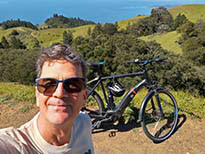* * *
Last night I finished the book, Untamed, that I mentioned in my last post. One of the hallmarks of a great story—and this is also a true story—is that it leaves you choked-up, in love with the cast of characters (good and bad), and with plenty of food for thought.
One of the great conflicts in the book (without giving away too much) involves humanity's insatiable appetite for wild-caught seafood, even when it involves a lot of collateral damage, or so-called bycatch. We are great at thinking up ways to turn wildlife into food and money, and Untamed was a good reminder that a lot of people—maybe even most—genuinely don't care about the cost to wild nature as long as they get what they want from it.
I can see their point. It's harder to care.
It's hard to admit that we—humanity in general—are doing all that killing. We are a diverse bunch: vegetarians and omnivores, peaceniks and roughnecks, rich and poor, lovers of life and miserable sonsabitches—and everything in between. We treat our beautiful, bountiful planet as if the shelves of the local store had plenty more of them. Earth all filthy and used up? Buy another one!
Not to mention that today is the 15th anniversary of 9/11. I don't think any event in my life has made me feel more patriotic and vengeful. What a world.
I feel lucky to be able to let it all go, to lighten my heart, even if just for a day, by heading out into nature. A day of recreation on Mt. Tam puts some distance on all the problems in the world. I can ruminate on the troubles out there (as if solutions will pop into my head!), only to get side-tracked by a carpet of tanoak leaves, the laughter of acorn woodpeckers, the movement of a squirrel, the scent of bay laurel leaves or sunkissed grass, a patch of rosinweed at season's end.
This is a shot of the same tanoak that appears in the picture before it, Tanoak Cornucopia. It's one of the tanoak's seven trunks. All those fallen leaves and catkins in the previous image are gathered in the hollowed-out middle of the seven sisters. I stopped at first because I've stopped at this tree many times in the past. Back in 2003 I made a photograph of the forest floor under the canopy of this tree, and I always remember that shot when I walk by.
I was on my way to Potrero Meadow to look for milkweed plants and monarch caterpillars. I don't think I've seen milkweed at Potrero Meadow since 2011, and I haven't seen a monarch caterpillar on a Mt. Tam milkweed since 2003.
I might not have thought a manzanita branch could still capture my interest after all these years, but what do you know. You never get tired of some things, I guess.
After I rounded Potrero Meadow (no sign of milkweed or even jimsonweed this year) I looked up at the edge of the forest and zeroed in on a nice fat acorn. It seemed as beautiful as a ripe peach, as if some primordial memory from my species' hunter-gatherer past had just discovered a treasure. I knew I wanted not just to photograph it, but to hold it in my hands for a while, so I carried it with me as I hiked back to the car. Wondering why an acorn would be fuzzy....
* * *
























































